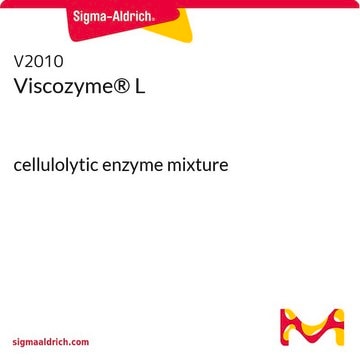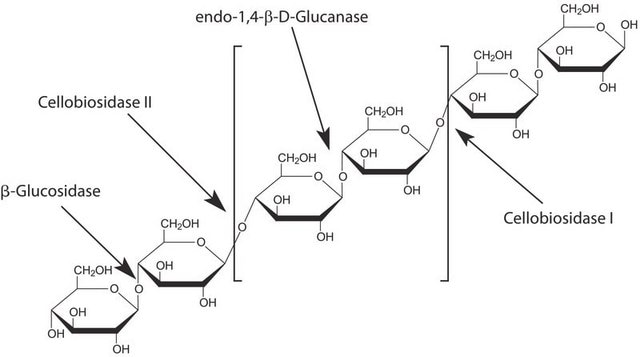The product is offered on the basis of activity. The purity has not been determined.
Kluczowe dokumenty
C1184
Cellulase from Aspergillus niger
powder, ≥0.3 units/mg solid
Synonim(y):
1,4-(1,3:1,4)-β-D-Glucan 4-glucanohydrolase
Wybierz wielkość
291,00 zł
Wybierz wielkość
About This Item
291,00 zł
Polecane produkty
Formularz
powder
Poziom jakości
aktywność właściwa
≥0.3 units/mg solid
charakterystyka ekologicznej alternatywy
Design for Energy Efficiency
Learn more about the Principles of Green Chemistry.
sustainability
Greener Alternative Product
kategoria ekologicznej alternatywy
, Enabling
temp. przechowywania
2-8°C
Szukasz podobnych produktów? Odwiedź Przewodnik dotyczący porównywania produktów
Opis ogólny
Cellulase belongs to the family of glycoside hydrolase,[1] which is secreted by various cellulolytic microorganisms.[2]
Zastosowanie
Działania biochem./fizjol.
Definicja jednostki
Inne uwagi
substrat
Hasło ostrzegawcze
Danger
Zwroty wskazujące rodzaj zagrożenia
Zwroty wskazujące środki ostrożności
Klasyfikacja zagrożeń
Resp. Sens. 1
Kod klasy składowania
11 - Combustible Solids
Klasa zagrożenia wodnego (WGK)
WGK 1
Temperatura zapłonu (°F)
Not applicable
Temperatura zapłonu (°C)
Not applicable
Środki ochrony indywidualnej
dust mask type N95 (US), Eyeshields, Faceshields, Gloves
Wybierz jedną z najnowszych wersji:
Certyfikaty analizy (CoA)
Nie widzisz odpowiedniej wersji?
Jeśli potrzebujesz konkretnej wersji, możesz wyszukać konkretny certyfikat według numeru partii lub serii.
Masz już ten produkt?
Dokumenty związane z niedawno zakupionymi produktami zostały zamieszczone w Bibliotece dokumentów.
Klienci oglądali również te produkty
Protokoły
To standardize an enzymatic assay procedure of cellulase.
Ten protokół wykorzystuje test spektrofotometryczny do oceny aktywności celulazy. Celulaza z Aspergillus niger katalizuje hydrolizę wiązań endo-1,4-β-D-glikozydowych.
-
Can you please provide the percent purity of the product?
1 answer-
Helpful?
-
-
Does product C1184 have hemicellulase activity, such as xylanase? I am looking for cellulase without hemicellulase activity.
1 answer-
Hemicellulase activity of this product has not been tested.
Helpful?
-
-
What is the solution stability of Cellulase, Product C1184?
1 answer-
Sigma-Aldrich has not determined the solution stability for this product. However, it is reported in Methods in Enzymology, 160, 264 (1988) that cellulase from Aspergillus niger is "completely stable over the range of pH 5.0-8.0 at 4°C for 24 hours and retains about 50% of its original activity after heating at 70°C for 10 minutes. The enzyme is completely inactivated by heating at 80°C for 10 minutes".
Helpful?
-
-
What is the molecular weight of Product C1184, Cellulase from Aspergillus niger?
1 answer-
The molecular weight is 26,000 Daltons.
Helpful?
-
-
Are there any additives to Cellulase, Product C1184, in addition to the enzyme itself?
1 answer-
Per information from our supplier, maltodextrin is an extender in this product. Maltodextrin can vary in glucose chain lengths of 2-12. There can also be some free glucose in the product. Either sorbitol or propylene glycol is added to the product as a stabilizer during processing. These components may be "flashed off" during processing, but some small amount may still be present.
Helpful?
-
-
What is the Department of Transportation shipping information for this product?
1 answer-
Transportation information can be found in Section 14 of the product's (M)SDS.To access the shipping information for this material, use the link on the product detail page for the product.
Helpful?
-
Active Filters
Nasz zespół naukowców ma doświadczenie we wszystkich obszarach badań, w tym w naukach przyrodniczych, materiałoznawstwie, syntezie chemicznej, chromatografii, analityce i wielu innych dziedzinach.
Skontaktuj się z zespołem ds. pomocy technicznej







